Research Article
IMPACT OF COVID-19 PANDEMIC ON TOURISM IN INDIA
6673
Views & Citations5673
Likes & Shares
The present study aims to examine the impact of COVID-19 pandemic on the tourism sector in India. Tourism in India has immense potential for its rich cultural and historical heritage, ecological diversity, terrains and places of natural beauty, flora and fauna spread across the country. It is an important source of employment and foreign exchange earnings. In the last few decades, it was growing at faster pace as compared to any other sector. Indian travel and tourism industry ranked 5th in terms of expected long-term (10-year) growth and was expected to be the second largest employer in the world by 2019. Its contribution to GDP reached to about 6 percent and 6.4 percent of total employment (i.e., 1 in every 15.6 jobs) in 2009. Its contribution has been growing over time and was expected to generate around 40,037,000 jobs i.e., 7.2% of total employment (1 in every 13.8 jobs) by 2019.
The outbreak of novel corona virus had a catastrophic impact on Indian economy, and the tourism sector is no exception. In this paper, descriptive statistics is used to assess the impact of COVID-19 on the tourism sector. The study finds a massive decline in Foreign Exchange Earnings (FEEs) and Foreign Tourist Arrivals (FTAs) during this pandemic period and taken the sector to a decade back. The study is further extended by providing recovery strategies for the revival and restoration of the tourism sector.
Key words: COVID-19, Pandemic, Tourism Sector, Indian Economy.
INTRODUCTION
COVID-19 is an infectious disease caused by the SARS-CoV-2 virus. First identified in the city of Wuhan, Hubei, China, the World Health Organization declared the outbreak a Public Health Emergency of International Concern on 30 January 2020, and a pandemic on 11 March 2020.The rapid spread of novel coronavirus (COVID-19) has led to a substantial reduction in all forms of economic activities all over the world. The first case of COVID-19 was reported in December 2019 in Wuhan China and spread all over the world within March. The COVID-19 pandemic has triggered an unprecedented crisis in the tourism industry all over the world.
Governments around the world have implemented various containment measures, such as travel bans and lockdowns, to prevent the spread of the disease due to locational movement and personal contacts. These travel restrictions and associated disruptions have created a direct and huge impact on travel activities. The United Nations World Tourism Organization (UNWTO) declared the travel industry to be one of the hardest-hit by the outbreak of the coronavirus disease (COVID-19).
The worst affected countries of the world in the order include USA, India, Brazil, Russia, Spain and Italy. The World Tourism Organization reported the loss of revenue during this pandemic. The complete lockdown imposed in response to the pandemic led to a 98% fall in international tourist numbers in the month of May 2020, when compared to the year 2019. It has also reported about 56% year–on–year drop in tourist arrivals between January and May. This translate into a fall of 300 million tourists and US $320 billion lost in international tourism receipt, which is three times the loss incurred during the Global Economic Crisis 2009. Thus, it can easily be understood what would be the consequences of COVID–19on India’s Tourism Industry.
Indian travel and tourism industry ranked 5th in terms of expected long-term (10-year) growth and was expected to be the second largest employer in the world by 2019. Its contribution to GDP reached to about 6 percent and 6.4 percent of total employment (i.e., 1 in every 15.6 jobs) in 2009. Its contribution has been growing over time and was expected to generate around 40,037,000 jobs i.e., 7.2% of total employment (1 in every 13.8 jobs) by 2019.
In India, at first it was found that only 26 people got infected after travelling internationally in January 2020. As prescribed by WHO, Indian government also took a serious note on Coronavirus pandemic by imposing immediate complete lockdown nationwide by 25th March 2020 and after a few months reopened with strict rules and regulations to be followed by all citizens. India is now the second worst - hit nation by the Pandemic after United States of America. The Federation of Associations of Tourism and hospitality industry estimated the loss to the tune of Rs10 lakhs crore due to COVID-19 pandemic. India’s coronavirus cases recorded as on 3rd December, 2021 to be 34,615,757 and the death recorded was 470,115 and recovered number was 34,145,642 (WHO).
Tourism industry is linked with almost every sector of the economy in the world, which positively and negatively affects the economy of a country. The purpose of this study is to examine the effect of COVID-19 on the tourism sector of India. Tourism in India has noteworthy potential by looking at its rich cultural and historical heritage, variety of ecology, terrains and places of natural beauty spread all over the country. It is considered to be the largest and rapidly growing industry. This study also presents the real scenario of tourism industry during COVID-19 pandemic which will help to know the update knowledge regarding the impacts of COVID-19 on tourism industry and to take proper recovery steps.
EMPIRICAL STUDIES
The new coronavirus outbreak had a catastrophic impact on global tourism (Yeh, 2020; Kumar, 2020). In the past, global tourism is affected by many disruptive events, such as terrorist attacks 9/11, epidemic outbreaks like SARS, Ebola, Swine Flu, and many others (Wen et al., 2020). But, the recent outbreak of epidemic (COVID-19) originated from Wuhan, China has severely affected almost every industry, including tourism worldwide.
The World Travel & Tourism Council predicts a tourism related loss of up to US$ 2.1 trillion in 2020 and up to 75 million jobs (WTTC, 2020). The first case of the Covid-19 pandemic in India was reported on January 30, 2020. After the first reported case government start the passenger’s scanning at all the airports. The Indian Government has taken immediate and first action on the air transport to shut down completely to fight against the disease Covid-19 and implemented lockdown on March 25, 2020. World Health Organization (WHO) reported the total confirmed cases of Covid19 in India are 1.64 million, with 35.75 thousand deaths till July 31, 2020.
The current outbreak of COVID-19 disease has developed into a global health threat with continuously rising numbers of confirmed cases (Lau et al., 2020). COVID-19 disease among individuals and related deaths continues to rise rapidly (Soof, et al., 2020). Therefore, the WHO announced the COVID-19 outbreak a pandemic on 11 March (Zhang, et al., 2020).
As tourism industry works with the amalgamation of too many other industries, it’s not possible to any single industry to recover the entire loss of tourism and hospitality industry. Directly or indirectly, the tourism industry is linked with other industries- transportation, accommodation, telecommunication, and entertainment. Therefore, the pandemic will have spillover to these industries (Hafsa, 2020; Rukh et al., 2020). (Ohlan, 2017) analyzed that tourism and economic growth has great relationship in short and in long run. Both public and private relevant organizations are advised to come forward to take proper recovery plans (Hafsa, 2020).
The adverse impact of Covid-2019 on the India economy has also been highlighted by Khan et al (2020). (Gossling, et al., 2020) have commented that with the ban and halting of operations of international flights has led to lay off in the tourism industry. Not only that, COVID-19 has posed operational, commercial, and financial crises to the tourism sector (Thams et al., 2020). (Upadhyaya & Mishra, 2020) observed that maintaining an effective balance between environmental sustainability and economic growth is a policy challenge.
The analysis is qualitative in nature. The research tool used for analyzing the data amassed from different secondary sources is comprehensive literature review, content analysis, and the descriptive analysis. For understanding the effect of COVID-19 outbreak on the Indian tourism sector, various published government reports, World Health Organization statistics, working papers, company websites, research papers, scholarly articles, historical records, as well as statistical databases are reviewed.
Impact of the COVID-19 Pandemic on Indian Tourism Sector
Tourism in India has been a significant source of foreign exchange earnings. Foreign exchange earnings increased from USD 3.4 billion in 2000 to USD 28.59 billion in 2018, showing positive signs of growth. Ministry of Tourism (2019) had targeted to reach USD 50 billion in earnings from tourism by 2022. However, during 2020 alone, due to pandemic, the foreign exchange earnings fell to US$ 6.15 billion and thus achieving USD 50 by 2022 looks a remote possibility (Statista, 2020).
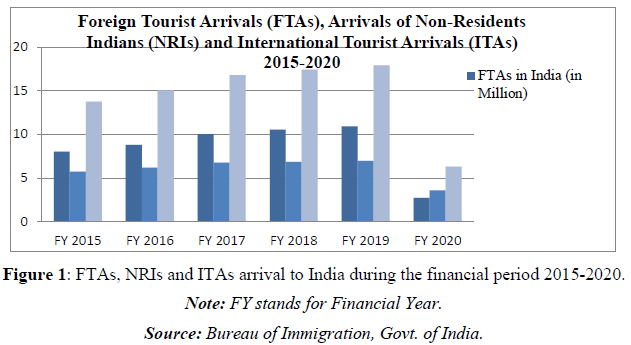

Figure 1 accounts the changes in foreign tourist arrivals in India, arrivals of non-resident Indians and international tourist arrivalsduring2015 to2020. It has been observed that the FTAs, NRIs and ITAs have increased over the years from 2015 and 2019. However, after the outburst of Covid-19 in 2020, the FTAs, NRIs and ITAs have declined significantly. Due to lockdown and imposed restrictions, significant loss of tourist arrival was seen in 2020.
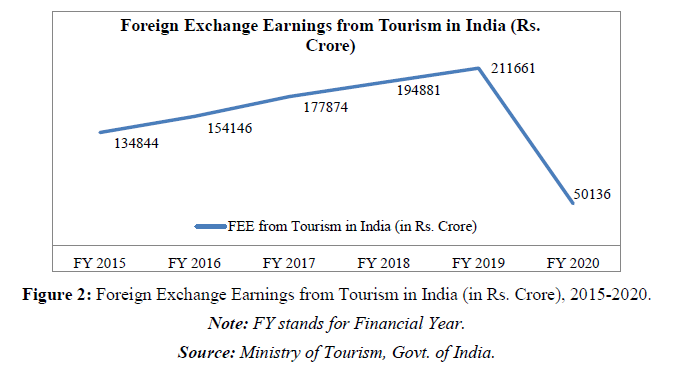

The decline in Foreign Tourist Arrival (FTAs) and Foreign Exchange Earnings (FEEs) from inbound tourism are visible. Previously, the SARS outbreak led to travel restrictions and advisories. Once again, the vulnerabilities of the tourism industry are exposed due to travel restrictions imposed by various countries keeping public health in mind (Zhang, et al., 2020) (Figure 2).
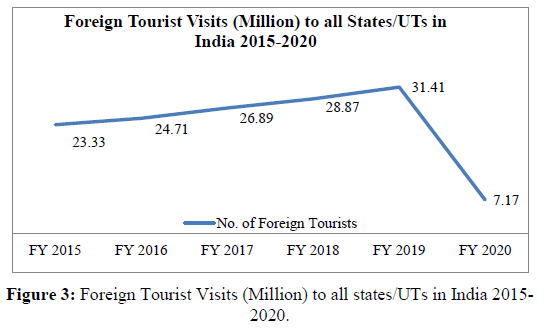
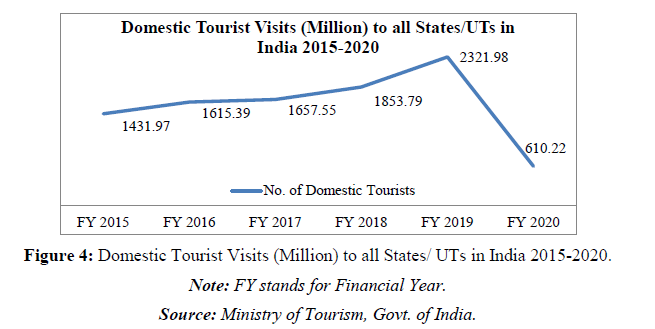


Muthukrishnan (2020) has pointed out that this pandemic will end up damaging industries for successive years. As the travel restrictions on both international and national flights continue, foreign and domestic tourists’ arrivals continued to decline which is shown in fig.3 & 4. The impact of the multiplier effect of tourism on the Indian economy, and simultaneous decline in the Foreign Tourists Arrivals (FTAs) and Foreign Exchange Earnings (FEEs) from tourism caused devastation for the Indian economy. Therefore, scholars have phrased this pandemic outbreak as ‘a recipe of disaster’ (Singh & Neog, 2020).
During the lockdown period, India had cancelled travel to over 80 countries, due to which the international flights were being suspended. The domestic flights were operational with regulations. Recently, after a decision of reopening international flight operations, the government retreated again and all international flight operations have been suspended till 30th January 2022 with the apprehension of new variant Omicron. The Indian domestic travelers and FTAs witnessed a significant decline in 2020 (Figure 3). India’s foreign tourists (FTA) arrival stood at 10.9 million and the foreign exchange earning stood at Rs. 210,971 crores during 2019 (Figure 4) Along with this, the cancellation of various events, functions and festivals caused a great job loss to many organizers and companies.
Pandemic hascaused a catastrophic impact on revenue and employment in Indian economy (Suman & Kumar, 2021). Before the pandemic, India’s travel and tourism industry was growing rapidly. The Indian tourism industry reckon for ₹16.91 lakh crore that is 9.2% of India’s GDP in 2018 and braced 8.1% of its employment. Tourism has significant contribution to GDP and supported an extensive job market directly and indirectly throughout the world.
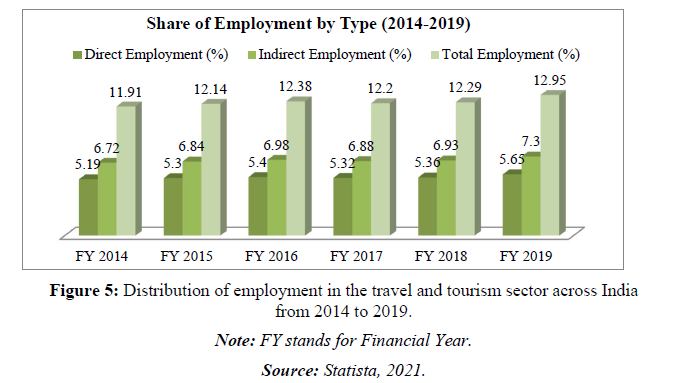

India is a major destination for many international tourists, creating several employment opportunities and generating taxes in India. According to the World Travel and Tourism Council (WTTC), tourism, being a strong driver for economic growth in the country, has created about 87.5 million jobs, with 12.29% of total employment in 2018-19, thereby contributing INR 194 billion to India’s GDP in the year 2019. Moreover, the sector recorded a 3.2% growth from 2018, with 10.8 million foreign tourists arriving in India and a foreign exchange earning of USD 29.9 billion in 2019.During the financial year 2019, the tourism industry of India contributed to nearly 13 percent of the total employment of the country. Thereby, the share in employment slightly increased compared to the previous year (Figure 5). The share of indirectly employed people in the industry is higher than the share of directly employed people. In comparison to financial year 2014, the share increased by more than one percent. In total, nearly 90 million people had been employed in the tourism industry in 2019. Unfortunately, it has been one of the worst-hit sectors by COVID-19, compelling people to confine themselves to the safety of their homes. Almost all the countries across the globe have commenced strict travel and tourism restrictions to fight against the pandemic’s spread. The WTTC is estimating losses of up to $2.7 trillion around the world in 2020, with up to 100 million jobs at risk.
Due to emerging lockdowns, restrictions, there is a 66.4% decline in overseas tourists’ arrivals in India in March 2020 as compared to its previous year (TAN, 2020). COVID-19 has rendered every unit of the tourism sector inactive. According to the Indian Association of Tour Operators (IATO), the hotel, aviation and travel sector together may incur losses of about INR 8,500 crore due to travel restriction imposed on foreign tourists by India. It has been estimated that there would be about 40-50 million direct and indirect job losses in India, with an annual loss in revenue of around USD 17 billion in India (FICCI, 2020, Scroll 2020). (Radhakrishnan, 2020) also predicted that 70% of the jobs would be lost in the tourism sector during the pandemic (Figure 6).
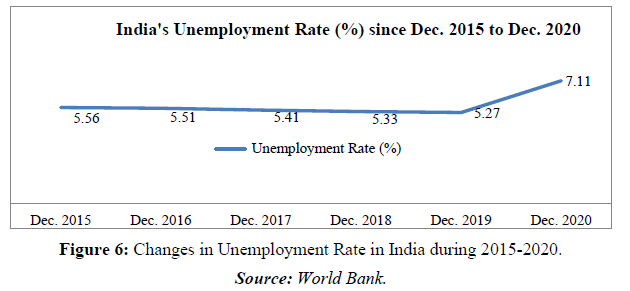

Figure 5 shows the changes in unemployment rate in India during the period 2015 to 2020. There is always decline in unemployment till December 2019, but due to pandemic, India’s unemployment rate for 2020 increased to 7.11%, showing an increase of 1.84% over 2019 figure. Unemployment rate in India is increasing due to massive job losses in tourism market as tourism is a multidisciplinary sector offering huge job opportunities from grass root to higher level offering significant contribution to the growth of an economy. Along with tourism, other interlinked sectors like local transportation, airline, railway, hospitality sector, entertainment, food and beverage, manufacturing and other connected industries are also adversely affected. As a result, there is hike in the unemployment rate because of the suspension of commercial activities for a long time leading to people losing jobs countrywide. With the tourism industry among the hardest hit due to the pandemic, it is estimated that about 21.5 million people working in the sector lost their jobs during the nine-month period from April 2020-December 2020 (The Hindu, July 28, 2021) (Figure 7).
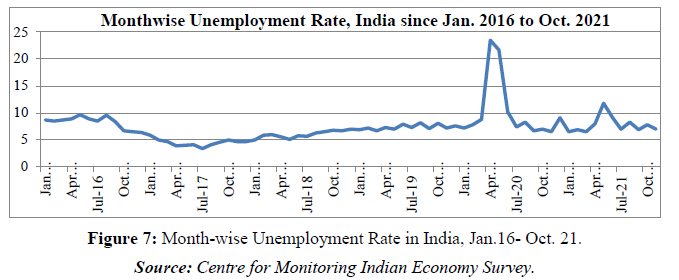

The Indian tourism and hospitality industry are gazing at a likely job loss of around 38 million, which is 70% of the total workforce due to the pandemic (Scroll, 2020). The travel and tourism companies in India are dealing with the miserable journey of canceled bookings from travelers which led to a “complete paralysis” in the market. The situation was worse between the periods February 2020 to late March 2020. If this shift resume as the Covid-19 destruction progresses, it will obstruct nation employment. Therefore, the lockdown throughout at simultaneous time impacted the overall economic activities and tourism activity which resulted in huge loss to this industry and comprehensive job loss.
The facts and analysis indicate that tourism industry keeps tight correlation with the economic growth of the economy of a nation, since tourism is linked with every sector of the economy. COVID-19 has severe adverse impact on the travel and tourism industry all over the world. Both domestic and international tourists cancelled their bookings due to the pandemic, and simultaneously, businesses are losing their revenue, and employees are losing their jobs. For the Indian travel and tourism industry, special stimulus package from the government is necessary to survive the current situation and revive after the pandemic. This is possible only after complete reopening of the international flights for tourists.
POLICY RECOMMENDATIONS
The pandemic has been a huge shock to the tourism economy, severely impacting people’s livelihood and business enterprises. As the effects are still evolving, the full consequences are not clear. Therefore, policy makers need to learn from the crisis to put up a stronger and resilient tourism economy for the future. While discussing about policy measures, a number of them are outlined here:
Integrated tourism policy approaches to support recovery: Government at all levels, along with the private sector need to adapt crisis response and management mechanisms which entail developing measures, plans and manuals to promptly respond to disaster events in an adequate way to minimize the negative impact to visitors and the tourism industry. Public-private partnership is extremely important in successful tourism crisis management at local, national and international level.
Efficient international co-ordinations are necessary to respond to future crisis: Countries need to work together as the actions taken by one country have implications for travelers and businesses in other countries, and for global tourism structure. Therefore, countries need to develop collaborative systems across borders to safely resume travel, restore traveler and business confidence, stimulate demand and accelerate tourism recovery.
The halt in tourism is having an extensive impact on the economy because of the interlinked nature of the sector with other sectors (e.g., food production, manufacturing agriculture, transport, business services). Therefore sector-specific supports are required to address the particular needs of the tourism workers, stakeholders, tourist destinations, business enterprises for wider economic recovery.
Domestic tourism: Under new normal situation, only the local tourists would be given priority for their prior knowledge and resilient capacity in the vicinity. The global tourism for the restoration of sector and the local economy would face the upcoming challenge. For sustainable development of the tourism industry, government need to come forward by helping the sector with contactless (as far as possible) scientific mechanism for the hospitality sector, which needs working capital, soft loans and adjournment on loan repayments. All these are inevitable in this condition to revive tourism economy of India.
CONCLUDING REMARKS
Coronavirus has a capacity to spread and mutate rapidly. After the first two waves, it is expected to have a third wave, with the new variant named Omicron. The variant may be more transmissible and better able to evade the body’s immune responses, both to vaccination and to natural infection, than other prior versions of the virus, experts said (The Indian Express, Nov. 30, 2021). As a result, it is expected that many international flights will not be operational in the upcoming months, and even if it continues, foreign tourists will be apprehensive of possible infection and health concerns and thus would restrict traveling. Various governments also have started controlling international travel again. In such a case, only the promotion of domestic tourism can edge the rage of this global crisis to some extent.
Travel and tourism sector relies heavily on trust. Thus, it may take a longer time to return to routine in the recovery period because tourists need to ensure that the situation is safe and secure before they step out to travel again. Companies need to regain the trust of travelers and ensure disinfecting major tourists’ destinations, including hotels and restaurants to accommodate them safe from Covid-19. Tourism industry also needs to offer different stimulus and discount packages for attracting domestic tourist, which will help to recover the losses. The future of tourism sector depends on how the virus transmission would happen and how it is contained. Thus, the policymakers in the tourism industry must develop a new crisis-readiness mechanism to fight the present pandemic crisis and its future movement.
- Chuo, H.Y. (2007). Theme Park Visitors Responses to the SARS Outbreak in Taiwan. Advances in Hospitality and Leisure 3, 87-104.
- Government of India, Economic Survey (2019-20). Available online at: https://www.indiabudget.gov.in/economicsurvey/
- Gössling, S., Scott, D. & Hall, C.M. (2020). Pandemics tourism and global change A rapid assessment of COVID19. Journal of Sustainable Tourism 29(1), 1-20.
- Hafsa, S. (2020). Impacts of COVID-19 Pandemic on Tourism & Hospitality Industry in Bangladesh. Available online at: http://dx.doi.org/10.2139/ssrn.3659196
- Khan, N., Hassan, A.U., Fahad, S., & Naushad, M. (2020). Factors affecting tourism industry and its impacts on global economy of the world. Available online at: http://dx.doi.org/10.2139/ssrn.3559353
- Khan, N., Fahad, S., Faisal, S., Naushad, M., & Akbar, A. (2020). COVID-2019 Review and Its Impact on Indian Economy. Available online at: http://dx.doi.org/10.2139/ssrn.3661625
- Kumar, V. (2020). Indian Tourism Industry and COVID-19: Present Scenario. Journal of Tourism and Hospitality Education 10, 179-185.
- Ministry of Tourism, India (2019). India Tourism Statistics. New Delhi Government of India. Available online at: https://tourism.gov.in/market-research-and-statistics
- Muthukrishnan, M. (2020). COVID-19 and its impact on Indian economy. Available online at: https://bfsi.eletsonline.com/covid-19-and-its-impact-on-indian-economy/
- Ohlan, R. (2017). The relationship between tourism financial development and economic growth in India. Future Business Journal 3(1), 9-22.
- Radhakrishna, S.A. (2020).COVID-19 Post pandemic Indias Tourism Sector Stares at 70% Job Loss. Available online at: https://www.thehindu.com/news/national/kerala/coronavirus-tourism-sector-stares-at-70-job-loss/article31310234.ece
- Rukh, L., Khan, F., & Mohammad, N. (2020). Potential Economic Impacts of COVID-19 on Tourism Industry of Pakistan A Review. Gaziantep University Journal of Social Sciences 19, 601-611.
- Safoora. (2020). After Zomato Swiggy sacks 1,100 workers. Available online at: https://www.siasat.com/after-zomato-swiggy-sacks1100-workers-1890707/
- Scroll. (2020). Indias Covid-19 lockdown may cause 38 million job losses in the travel and tourism industry. Available online at: https://scroll.in/article/959045/indias-covid-19-lockdown-may-cause-38-million-job-losses-in-the-travel-and-tourism-industry
- Singh, M.K., & Neog, Y. (2020). Contagion effect of COVID‐19 outbreak Another recipe for disaster on Indian economy. Journal of Public Affairs 20(4), 2171.
- Statista. (2020). Available online at: https://www.statista.com/statistics/1104835/coronavirus-travel-tourism-employment-loss/
- Suman, R., & Kumar, V. (2021). A Preliminary Study of the Impact of Novel Coronavirus Disease COVID-19 on Tourism Sector of India. Brazilian Annals of Tourism Studies ABET 11, 1-12.
- TAN. (2020). Foreign tourist arrivals to India tumble over 66% in March owing to coronavirus pandemic. Available online at: https://travelandynews.com/foreign-tourist-arrivals-to-india-tumble-over-66-in-march-owing-to-coronavirus-pandemic/
- Thams, A., Zech, N., Rempel, D., & Ayia-Koi, A. (2020). An initial assessment of economic impacts and operational challenges for the tourism & hospitality industry due to COVID19 IUBH Discussion Papers. Tourismus & Hospitality. Available online at: http://hdl.handle.net/10419/216762
- UNWTO. (2020). UNWTO World Tourism Barometer 18, (2) Madrid Spain UNWTO. https://doi.org/10.18111/wtobarometereng
- Wen, J., Wang, W., Kozak, M., Liu, X., & Hou, H. (2020). Many brains are better than one the importance of interdisciplinary studies on COVID-19 in and beyond tourism. Tourism Recreation Research 1-4.
- World Bank, World Development Indicators. (2020). Available online at: https://databank.worldbank.org/source/world-development-indicators
- World Health Organization WHO Coronavirus Disease COVID-19 Dashboard. (2021). World Health Organization. Available online at: https://covid19.who.int
- Worldometers. Report coronavirus cases. (2021). Worldometer Available online at: https://www.worldometers.info/coronavirus
- WTTC (2020). Latest research from WTTC shows a 50% increase in jobs at risk in Travel &Tourism. Available online at: https://wttc.org/News-Article/Latest-research-from-WTTCshows-a-50-percentage-increase-in-jobs-at-risk-in-Travel-andTourism
- Yeh, S.S. (2020). Tourism recovery strategy against COVID-19 pandemic. Tourism Recreation Research 1-7.
- Zhang, H., Cho, T., & Wang, H. (2020). The impact of a terminal high altitude area defense incident on tourism risk perception and attitude change of Chinese tourists traveling to South Korea. Sustainability 12(1), 7.









